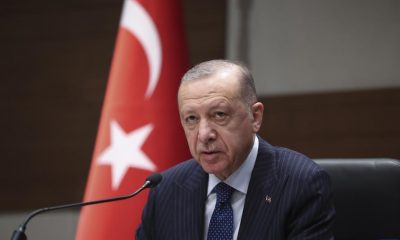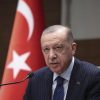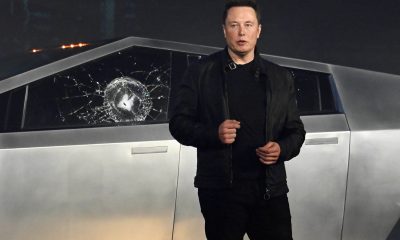LATEST FINANCIAL NEWS
Trump wields more powerful weapon than tariffs in trade war
[ad_1]
President Donald Trump’s trade war against China has so far focused on attacking imports. His new front: Weaponising American exports.
The Trump administration is seeking to choke off Beijing’s access to key technologies by limiting the sale of vital US components to China’s Huawei Technologies. The US is considering putting at least five Chinese surveillance companies on the same blacklist.
The moves are part of a bigger effort by the US to expand and toughen the export control regime that for decades has curbed the sale of defense-related technologies to rogue regimes and strategic rivals. It’s a process that has prompted fears from business that as Trump’s trade war grows into a broader technology-driven conflict with China the US could end up damaging its own economic future.
In closed-door deliberations the administration since last year has been discussing with companies and industry groups how to update and redefine the products on the Commerce Department’s export control list, a process that is expected to gel in the coming weeks.
Administration hawks are pushing for broad definitions to restrict exports related to technologies such as artificial intelligence, robotics and 3D printing that they call essential to competitiveness. The new regulations could also limit the ability of companies to hire foreign engineers and scientists to work in affected areas as the knowledge they gain is considered a sensitive “deemed” export.
That fits with the Trump administration’s mantra that economic security is national security. So far the administration has used that to justify tariffs on steel and aluminum and to threaten more import duties on cars and parts from the EU and Japan. More broadly it has used economic tools like stricter national-security screening on Chinese investments in the US and financial sanctions to pursue other policy goals such as protecting Pentagon supply chains and isolating governments in places like Iran and Venezuela.
‘Very Dangerous’
On Thursday, Trump described Huawei as “very dangerous,” even as he said it could be included in some kind of trade deal with China. And in a move that may broaden Trump’s trade salvos, his administration proposed tariffs on goods from countries found to have undervalued currencies.
China’s reaction to the US actions has become increasingly strident.
“All of the Chinese people are ready to embark on a new ‘Long March’ journey with greater courage and resilience and will never yield to foreign bullying and assault,” state-run Xinhua News Agency said in a commentary on Friday. The US “continues to attack Chinese companies not because they have done anything wrong, but because they are too outstanding for the United States to accept.”
Accusations that Huawei is a risk to US national security are “lies to try to mislead the American people,” Foreign Ministry Spokesman Lu Kang said in Beijing on Friday, when asked about U.S. Secretary of State Mike Pompeo’s comments that Huawei was deeply tied to the Chinese Communist Party.
Some US businesses fear the export controls more than tariffs. Companies like General Electric, Google and Microsoft are worried it could bar them from competing in lucrative markets while reducing America’s capacity to innovate.
In a written submission to Commerce, Microsoft warned that the proposed restrictions risked isolating the US from international research collaborations behind the development of many technologies, and that done wrongly, a new regime “could thwart US interests”.
“Artificial intelligence is a very broad concept,” GE cautioned in its own submission. Defined too broadly, export controls could sweep up things like medical imaging where algorithms are being used to scan for diseases and toys like talking teddy bears, it said.
Behind the fear expressed by American companies is a concern that a normally balanced debate to update the list of restricted exports could be dragged into a trade war between the world’s two biggest economies increasingly being guided by hawks in the administration.
Congress last year passed a law pushed by the White House ordering Commerce to update its export-control regime to include “emerging” and “foundational” technologies.
The discussions over the changes are ongoing and the administration will likely publish new regulations on emerging technologies in the summer. It’ll define “foundational” technologies later this year.
The debate over how sweeping export restrictions should be has always been a tug of war between a Commerce Department in charge of promoting exports and the more hawkish Defense Department. But people familiar with internal deliberations said that balance has shifted with control of the process increasingly in the hands of hardline Trump administration officials pushing for stringent controls.
A Commerce spokeswoman declined to address specific questions about the export control review but said the department was working with US businesses, academia and other agencies.
Smart Dust
The US’s export control system has for years targeted things like fissile material, communications and cybersecurity equipment, lasers, and even space vehicles. The 14 categories of emerging technologies listed in a proposed Commerce Department rule last November included areas like biotechnology, advanced surveillance systems, and robotics including specific things like “smart dust,” speck-sized networked sensors.
According to a person briefed on the discussions, the administration has since narrowed its focus to three emerging technologies: artificial intelligence, quantum technologies and sensing advances and technologies like 3D printing.
But the process has also led to fractures within the Commerce Department and battles between career staff and political appointees, according to people familiar with the deliberations. Several officials considered more moderate have either recently left the agency or been accused of foot-dragging and sidelined in the discussions. The political appointees who have seized control of the process are pushing for the new restrictions to be implemented quickly.
Bill Reinsch, who oversaw the US export-control regime in the Clinton administration, said striking the right balance to protect national security while not stifling innovation is a hard task.
“It’s always tricky to get export controls right. Too lax and critical technologies end up in the hands of our adversaries. Too strict and we limit our high tech companies’ ability to grow and further innovate, and we encourage others to develop their own capabilities in critical sectors,” he said.
The actions against Huawei illustrate the power of the US export-control regime. They also illustrate the dilemma facing policy makers, Reinsch said. Huawei has long been the target of concerns from the US intelligence community and was placed on the so-called “entity list’’ for allegedly violating US export controls by selling restricted components to Iran.
Already the moves have had a significant impact on the shares and business models of Huawei suppliers in the US like Qualcomm and other chipmakers. And that could be just the start.
In a report published this month, researchers at the Information Technology and Innovation Foundation warned that a crackdown on US tech exports would put as much as $56 billion in exports and 74 000 jobs at risk over five years. They also warned that in trying to force a repatriation of supply chains the Trump administration risked undermining the very economic dynamism it’s trying to promote.
“A more effective strategy is to say what is the next generation of advanced technologies and what is required for them to be produced in the United States,” said Stephen Ezell, one of the report’s authors. The administration “has got to recognise that policies like export controls are not an unalloyed good.”
[ad_2]
Source link









